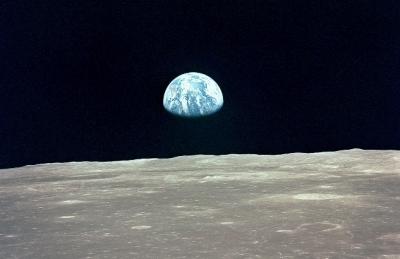The Blue Planet
When seen from a distance the earth appears as a blue marble with white spots. The blue colour is caused by sunlight scattered in the atmosphere and in ocean surface waters, the white spots are clouds in the sky.

Photo: NASA-Johnson Space Center
A closer look at the earth also reveals yellow, brown and green colours where continents and islands are visible. However, their colours are often obscured due to stray light from atmospheric gases and, more importantly, aerosol particles.
Photo: NASA-Johnson Space Center
Sunlight shining on a clean atmosphere evokes a lucent blue dome of air. Rain clouds darken the sky, but sunlight falling on raindrops excite a brilliant rainbow of bright colours.

Photo: Svetlana Patsaeva
The rainbow includes all colours from blue over green, yellow, orange and red which all together appear as white light to the eye of an observer. Zooming into the photo and comparing the rainbow with a blue-to-red colour scale shows us that these colours are the same.
A glittering water surface reflects the horizon's skylight, but the colour of the water is also due to particles in the water column which reflect the daylight.
Indeed, our planet is full of a variety of ![]()
In this tutorial we would like you to think about...
- ... the models used in physics to characterise light and radiation and its spectral properties
- ... the light emitted by the sun, and how the sunlight is scattered in the atmosphere by gases, aerosols and clouds
- ... the amount of sunlight reaching the earth surface, and how it is reflected by land surfaces and oceans, exciting the colours that we can see from space
- ... the thermal radiation emitted by all objects, also by the earth surface and the clouds in the atmosphere
- ... narrow spectral lines or bands emitted (but also absorbed!) by atoms and molecules in the atmosphere
- ... the atmosphere which absorbs part of the radiation emitted by the earth surface, leading to the so-called greenhouse effect
- ... the balance of sunlight received and radiation emitted by the earth which is at risk due to increasing amounts of atmospheric greenhouse gases, leading to climate change
- ... instruments used to measure the intensity of light and the variation of the intensity at different colours
- ... how all this is done with satellites surrounding the earth!
